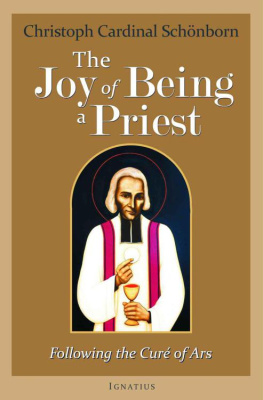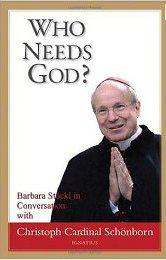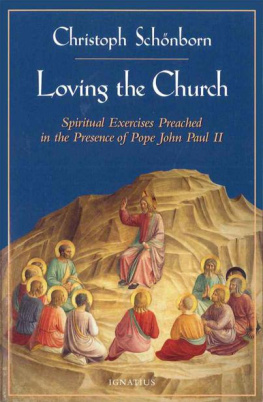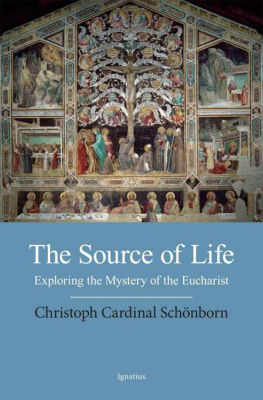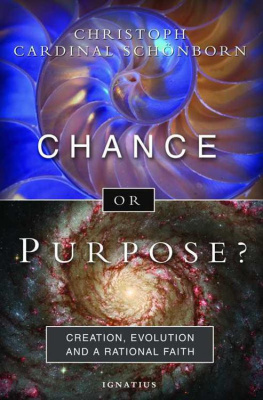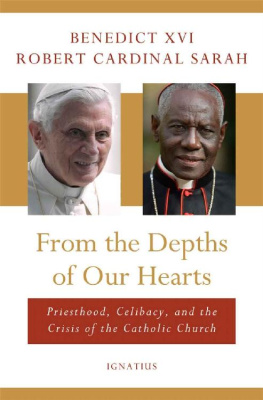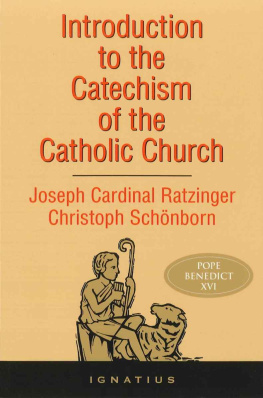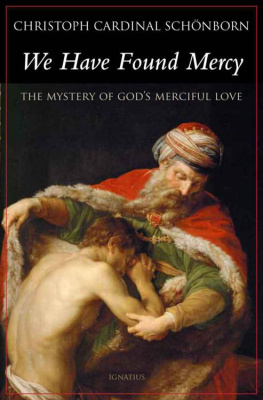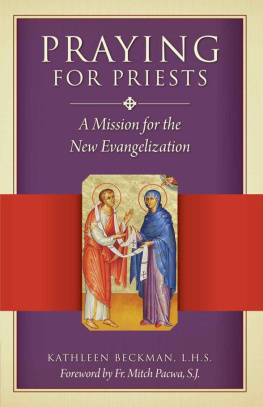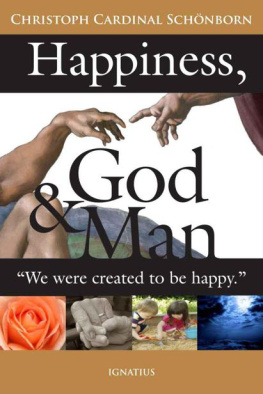THE JOY OF BEING A PRIEST
CHRISTOPH CARDINAL SCHNBORN
The Joy of
Being a Priest
Following the Cur of Ars
TRANSLATED BY
MICHAEL J. MILLER, M.A. THEOL.
IGNATIUS PRESS SAN FRANCISCO
Original French edition: La Joie dEtre Prtre: la suite du Cur dArs . 2009 by ditions des Batitudes, S.O.C., Nouan-le-Fuzelier, FranceUnless otherwise noted, Scripture quotations (except for those within citations) have been taken from the Revised Standard Version of the Holy Bible, Second Catholic Edition, 2006. The Revised Standard Version of the Holy Bible: the Old Testament, 1952, 2006; the Apocrypha, 1957, 2006; the New Testament, 1946, 2006; the Catholic Edition of the Old Testament, incorporating the Apocrypha, 1966, 2006, the Catholic Edition of the New Testament, 1965, 2006 by the Division of Christian Education of the National Council of the Churches of Christ in the United States of America. All rights reserved.In a few cases the Scripture wording has been adapted to conform to the authors text.Excerpts from the English translation of the Catechism of the Catholic Church for use in the United States of America copyright 1994, United States Catholic Conference, Inc.Libreria Editrice Vaticana. English translation of the Catechism of the Catholic Church: Modifications from the Editio Typica copyright 1997, United States Catholic Conference, Inc.Libreria Editrice Vaticana.
Cover icon written by Michael D. OBrien
Cover design by Riz Boncan Marsella
2010 by Ignatius Press, San Francisco
All rights reserved
ISBN 978-1-58617-476-7
Library of Congress Control Number 2010922766
Printed in the United States of America
Contents
1. Gods plan: To form his family, the Church
2. The Apostles and their successors: Servants of Gods plan
3. Baptismal priesthood and ministerial priesthood: The Councils teaching
1. In the school of the mercy of Jesus
2. Confession, the tribunal of mercy
1. The happiness of praying
2. The prayer of Jesusplace of our prayer
3. The battle of prayer
4. From battle to confidence
1. The Eucharist, source of joy and life
2. The gift of the Eucharistentrusted to very fragile men
Introduction: The Call of the Twelve
1. Question of Father Francis Jones, missionary in Latin America, on the life of prayer
2. Question of Father Pierre-Emmanuel from Switzerland on youth evangelization
Testimony of Sister Catherine of the Trinity
Response of Cardinal Schnborn
3. Question from Father Antonio, a Portuguese priest from a diocese south of Lisbon, on exorcism and the practice thereof
4. Question of Father Marion about divorced and remarried Catholics
1. Marys faith
2. The pastoral approach of Mary
CHAPTER ONE
The Priestly Vocation: Consecrated
for the Salvation of the World
It is with fear and trembling that I approach the theme of our priestly vocation in this book, which is a continuation of the retreat for priests that brought us together in Ars in October 2009. I am quite aware that many priests would be much better qualified than I to speak about it. I know priests who could give us the testimony of a life of total dedication; theologians who could help us to probe the teaching of the Church; witnesses to the faith who have undergone trials and become martyrs or confessors of the faith. I am tempted to become discouraged when I look at my own misery and poverty. But there is a prayer of Saint Thrse of the Child Jesus that puts me in my place and gives me the courage to pursue this work. Here is the prayer of Thrse:
Lord, my weakness is known to you; every morning I make a resolution to practice humility, and in the evening I recognize that I have again committed many faults of pride; on seeing this I am tempted to become discouraged, but I know that discouragement, too, comes from pride. Therefore, O my God, I want to base my hope on You alone.
Discouragement, too, comes from pride: how true! This statement by little Thrse gives me the courage to take up the task entrusted to me of presenting this synthesis on the different aspects of priestly ministry and of the vocation to the priesthood. I wish to proceed, then, with confidence, without looking too much at my own misery but rather inviting you with Thrse, with Faustina, with so many saints, to trust. It is confidence and nothing but confidence that must lead us to Love, Thrse writes to her sister, Marie of the Sacred Heart.
In this trust, let us set out on the path of this meditation: Jezu, ufam tobie , Jesus, I trust in you. May Thrse help us to follow her little way, about which she wrote in a letter to Father Roulland, the young priest whom she had adopted as her brother: [See, my brother,]... my way is all confidence and love. I do not understand souls who fear a Friend [who is] so tender.
1. Gods plan: To form his family, the Church
To introduce my reflection, I offer you two sayings of the saintly Cur of Ars as the vestibule, as the key words for this whole book. The first is quoted in the beautiful Letter of Benedict XVI to priests (June 16, 2009):
The priesthood is the love of the heart of Jesus.
It really says what the identity of the priest is. The second defines his vocation . You all know the beautiful anecdote about the arrival of the saintly Cur in Ars. Unable to find the way to Ars because of the fog, Monsieur Vianney asked a boy who was watching his sheep; the youngster, by the name of Antoine Givre, showed him the road. Then the future saint replied:
My young friend, you have shown me the way to Ars; I shall show you the way to heaven.
I would like to make this meditation in the light of these two very simple sayings. Since the priest is the love of the heart of Jesus, he is entirely at the service of what the love of Jesus desires for us: heaven, blessings, eternal happiness, the beatitude of the living God. God desires our happiness and he intended that the priest should be the servant of his blessings: I will show you the way to heaven, the way to happiness!
In order to speak to you about the identity and mission of the priest, I will refer often to the Catechism of the Catholic Church . It is a real treasure. I do not say that because I collaborated as secretary in composing it but rather because it is truly a gift of the Church to us all. It is a synthetic and organic presentation of the Catholic faith. In browsing through it, the reader truly experiences the fact that truth is symphonic (Hans Urs von Balthasar). To begin with, then, let us open the Catechism to paragraph 1:
God, infinitely perfect and blessed in himself, in a plan of sheer goodness freely created man to make him share in his own blessed life. For this reason, at every time and in every place, God draws close to man. He calls man to seek him, to know him, to love him with all his strength. He calls together all men scattered and divided by sin, into the unity of his family, the Church. To accomplish this, when the fullness of time had come, God sent his Son as Redeemer and Savior. In his Son and through him, he invites men to become, in the Holy Spirit, his adopted children and thus heirs of his blessed life.
This is the object of all human life. This is the purpose of the priests ministry: to lead souls to heaven, to lead them to happiness, to the blessed life of the Most Holy Trinity. The Church has no other purpose than to gather men who have been scattered and divided by sin into the unity of his family.
How I would love to elaborate at greater length on this grandiose vision set forth in paragraph 1 of the Catechism of the Catholic Church! It is extremely important that we be impressed by this supreme reality, this primary and foundational datum of all reality: God, infinitely perfect and blessed in himself! See what strength, what consolation, what rest we find in this word, in this abyss of the reality of the living God: God is! God is infinitely perfect and blessed in himself! In this earthly life so full of dangers, in which nothing lasts and everything changes and we are often tormented, troubled, anxious and above all miserable, what a comfort it is to think that God is: [In him] there is no variation or shadow due to change (Jas 1:17).
Next page
